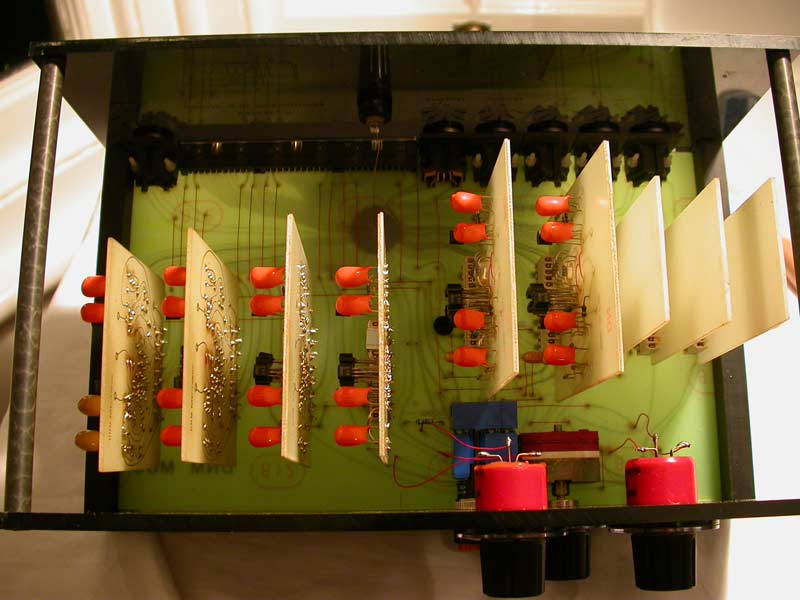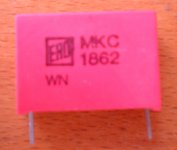Not every application was reliable and good with DC. Radio consoles of the time were plagued with the little cherrybombs in coupling and PS bypass positions. I learned to despise tantulums for their shorting failure mode after the 4th or 5th overnight call-in.
Hey anatech, can you eleborate on the better old prod electros? Just two nights ago I swapped out the original PS caps in a 25 year old Yamaha CT-1010 for Panasonic FCs, more out of due diligence than anything else, and was amazed by the improvement. The tuner had been under power for a couple weeks prior so the old electros were fully reformed.
Hey anatech, can you eleborate on the better old prod electros? Just two nights ago I swapped out the original PS caps in a 25 year old Yamaha CT-1010 for Panasonic FCs, more out of due diligence than anything else, and was amazed by the improvement. The tuner had been under power for a couple weeks prior so the old electros were fully reformed.
rdf said:Not every application was reliable and good with DC. Radio consoles of the time were plagued with the little cherrybombs in coupling and PS bypass positions. I learned to despise tantulums for their shorting failure mode after the 4th or 5th overnight call-in. [snip]
Yeah. The only components I had ever fail without being overloaded were tantalums. And I saw a LOT going in the 80's.
Jan Didden
john curl said:They showed this to me in Feb. 1974. I told Bruel & Kjaer within the year, and a section was added to a technical paper showing the distortion.
I recall that we both attended a B&K seminar around then,
and you spent the break time pontificating on the subject.
😎
Hi rdf,
I was talking about the signal caps mostly. I don't change main supply caps unless I can see "pips" on the leading edge of the ripple. The better products had local bypass caps the often needed changing.
I'm guessing that technicians will never trust those tantalum capacitors again. That's why I asked about Oscon types. I don't trust them.
-Chris
I was talking about the signal caps mostly. I don't change main supply caps unless I can see "pips" on the leading edge of the ripple. The better products had local bypass caps the often needed changing.
Oh yeah! I hate the little beggars for the same reasons. Some even shorted in signal applications where they created weird and wonderful faults.I learned to despise tantulums for their shorting failure mode after the 4th or 5th overnight call-in.
I'm guessing that technicians will never trust those tantalum capacitors again. That's why I asked about Oscon types. I don't trust them.
-Chris
Yes, Nelson, I am known to 'pontificate' I can't place the B&K seminar exactly in that time period, BUT I was really impressed with what Tektronix had showed me, and I tend to share with everyone else. Gets me into trouble. I should just keep my mouth shut and covertly laugh at the mistakes and misunderstandings that many designers sometimes have.
I can't place the B&K seminar exactly in that time period, BUT I was really impressed with what Tektronix had showed me, and I tend to share with everyone else. Gets me into trouble. I should just keep my mouth shut and covertly laugh at the mistakes and misunderstandings that many designers sometimes have.
I modified my 577 to do the same thing, as soon as I could. Later, I realized that harmonic and IM measurements were possible too, but I had overlooked this problem before 1974, as do many designers today.
Thanks again for the computer, I have no display yet. Hope to get one in a few weeks.
 I can't place the B&K seminar exactly in that time period, BUT I was really impressed with what Tektronix had showed me, and I tend to share with everyone else. Gets me into trouble. I should just keep my mouth shut and covertly laugh at the mistakes and misunderstandings that many designers sometimes have.
I can't place the B&K seminar exactly in that time period, BUT I was really impressed with what Tektronix had showed me, and I tend to share with everyone else. Gets me into trouble. I should just keep my mouth shut and covertly laugh at the mistakes and misunderstandings that many designers sometimes have. I modified my 577 to do the same thing, as soon as I could. Later, I realized that harmonic and IM measurements were possible too, but I had overlooked this problem before 1974, as do many designers today.
Thanks again for the computer, I have no display yet. Hope to get one in a few weeks.
I should ... covertly laugh at the mistakes and misunderstandings that many designers sometimes have.
Attachments
john curl said:I can't place the B&K seminar exactly in that time period
It was specifically 1973, as I was employed by ESS at the time.
I didn't like the B&K rep - if you asked a question to which he
didn't know the answer, he would let you know that you weren't
advanced enough to talk to him.
😎
Nelson Pass said:.... if you asked a question to which he didn't know the answer, he would let you know that you weren't advanced enough to talk to him.
Working in a high end shop now? 😉
UK-made
Tantalums banned from my desings
Ditto for polypropylenes. Ditto ceramics.... Ditto silver-mica......
Only allowed fore stuffing in Russian Teflons K72P-6
Friendly guys on Ebay and quite affordable prices.
🙂
I suspected it was UK-made and after checking the link I was informed being right.tvi said:
Tantalums banned from my desings
Ditto for polypropylenes. Ditto ceramics.... Ditto silver-mica......
Only allowed fore stuffing in Russian Teflons K72P-6
Friendly guys on Ebay and quite affordable prices.
🙂
dimitri said:-60dB passive notch (tuneable twin Tee) -> 4 stages of low noise amplification w bandbass filtering 50dB@100Hz, 20dB@20kHz -> analyzer
Hi Dimitri,
Thanks for adding details about Cyril's distometer, my description was too short indeed.
I didn't know about capacitor distortion in 1973. I did know from working with Mark Levinson, that some caps sounded better than others. I still used ceramics then for bypassing and compensation. I can't remember the B&K rep, but I did show someone from B&K how to lower the noise of their mikes by 10dB. They used my idea, charged me for the upgrade, and gave no further attribution to me. They did the same thing with the cap distortion thing about 1 year later. I moved to Switzerland in 1974, and they came to visit me there, and that's when they learned about the ceramics. No attribution in this case either. Finally, when the guy from Ortofon took my patented JC-1 circuit as his own, I gave up on sharing with a certain group of individuals. It cost too much!
john curl said:I didn't know about capacitor distortion in 1973.
Being slightly older than me buys you an excuse. I was there
and you really were discussing this subject (authoritatively) in
1973.
😎
I remember the B&K meeting, somewhat. We were using their 1/2 inch mikes for far-field differential cancelation, and we had one of their big real time analyzers that we took to concerts.
My friend Geoff Cook was really big on polycarbonate caps at the time, so was Mark Levinson. Still, I can't remember ever measuring any distortion in the caps, directly, at the time. This was when I was still working with the Grateful Dead, I suppose.
My friend Geoff Cook was really big on polycarbonate caps at the time, so was Mark Levinson. Still, I can't remember ever measuring any distortion in the caps, directly, at the time. This was when I was still working with the Grateful Dead, I suppose.
john curl said:..... My friend Geoff Cook was really big on polycarbonate caps at the time, so was Mark Levinson..........
The original JC-2 preamp was full of polycarbonates...
After that Mark Levinson changed to those pink/purple ERO MKC1862. These have a certain mellow euphonic colaration
Definitely not neutral but it seems to be the sound Madrigal is after.
jacco vermeulen said:You think Madrigal fancied the colour, "Quantico" ?
Maybe the favorable footprint, MKC or MKP made no real difference prise wise.
Polycarbonate is very compact but I think they liked the sound of it.
It went on for years till they turned the IC-route.
See also www.marklev.com
Polycarbonate measures lower DA than Mylar. Polystyrene or Teflon is my normal choice, even for Parasound.
john curl said:
This was when I was still working with the Grateful Dead, I suppose.
Not to put too fine a point on it, but could your lack of memory of the times in question have anything to do with company you were keeping? If so, you are in good company. A number of us might be accused of...er...lapses of memory during that era.
Grey
- Status
- Not open for further replies.
- Home
- Amplifiers
- Solid State
- John Curl's Blowtorch preamplifier



